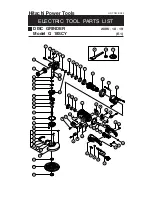
12 ENGLISH
Abrasive cut-off wheel
Diamond wheel
Thickness: Less than 4 mm (5/32")
Thickness: 4 mm (5/32") or more
16 mm (5/8")
20 mm (13/16")
22.23 mm (7/8")
Abrasive cut-off wheel
Diamond wheel
Thickness: Less than 4 mm (5/32")
Thickness: 4 mm (5/32") or more
Thickness: Less than 4 mm (5/32")
Thickness: 4 mm (5/32") or more
Thickness: Less than 4 mm (5/32")
Thickness: 4 mm (5/32") or more
22.23 mm (7/8")
22.23 mm (7/8")
22.23 mm (7/8")
16 mm (5/8")
20 mm (13/16")
1
2
3
1
4
3
100 mm (4") model
115 mm (4 - 1/2") / 125 mm (5") / 150 mm (6") model
1
2
3
1
4
3
Lock nut
Abrasive cut-off wheel
Inner flange
Diamond wheel
1.
2.
3.
4.
Lock nut
Abrasive cut-off wheel
Inner flange
Diamond wheel
1.
2.
3.
4.
WARNING:
•
When using an abrasive cut-off / diamond
wheel, be sure to use only the special wheel
guard designed for use with cut-off wheels. (In
some European countries, when using a dia
-
mond wheel, the ordinary guard can be used.
Follow the regulations in your country.)
•
NEVER use cut-off wheel for side grinding.
•
Do not "jam" the wheel or apply excessive
pressure. Do not attempt to make an excessive
depth of cut. Overstressing the wheel increases
the loading and susceptibility to twisting or
binding of the wheel in the cut and the possibility
of kickback, wheel breakage and overheating of
the motor may occur.
•
Do not start the cutting operation in the work
-
piece. Let the wheel reach full speed and care-
fully enter into the cut moving the tool forward
over the workpiece surface. The wheel may
bind, walk up or kickback if the power tool is
started in the workpiece.
•
During cutting operations, never change the
angle of the wheel. Placing side pressure on
the cut-off wheel (as in grinding) will cause the
wheel to crack and break, causing serious per
-
sonal injury.
•
A diamond wheel shall be operated perpendicu
-
lar to the material being cut.
Operation with wire cup brush
(optional accessory)
CAUTION:
•
Check operation of brush by running tool with no
load, insuring that no one is in front of or in line
with brush.
•
Do not use brush that is damaged, or which is
out of balance. Use of damaged brush could
increase potential for injury from contact with
broken brush wires.
►
Fig.20:
1.
Wire cup brush
Unplug tool and place it upside down allowing easy
access to spindle. Remove any accessories on spindle.
Thread wire cup brush onto spindle and tighten with
supplied wrench. When using brush, avoid applying too
much pressure which causes over bending of wires,
leading to premature breakage.













































